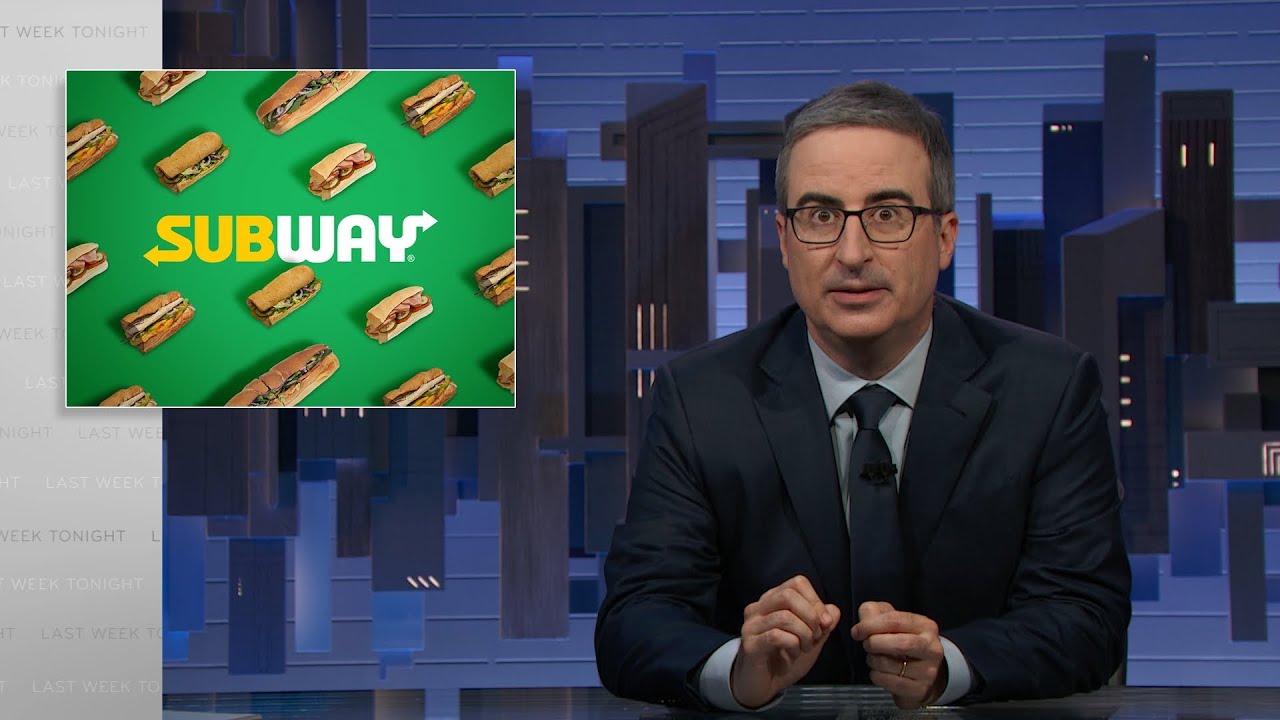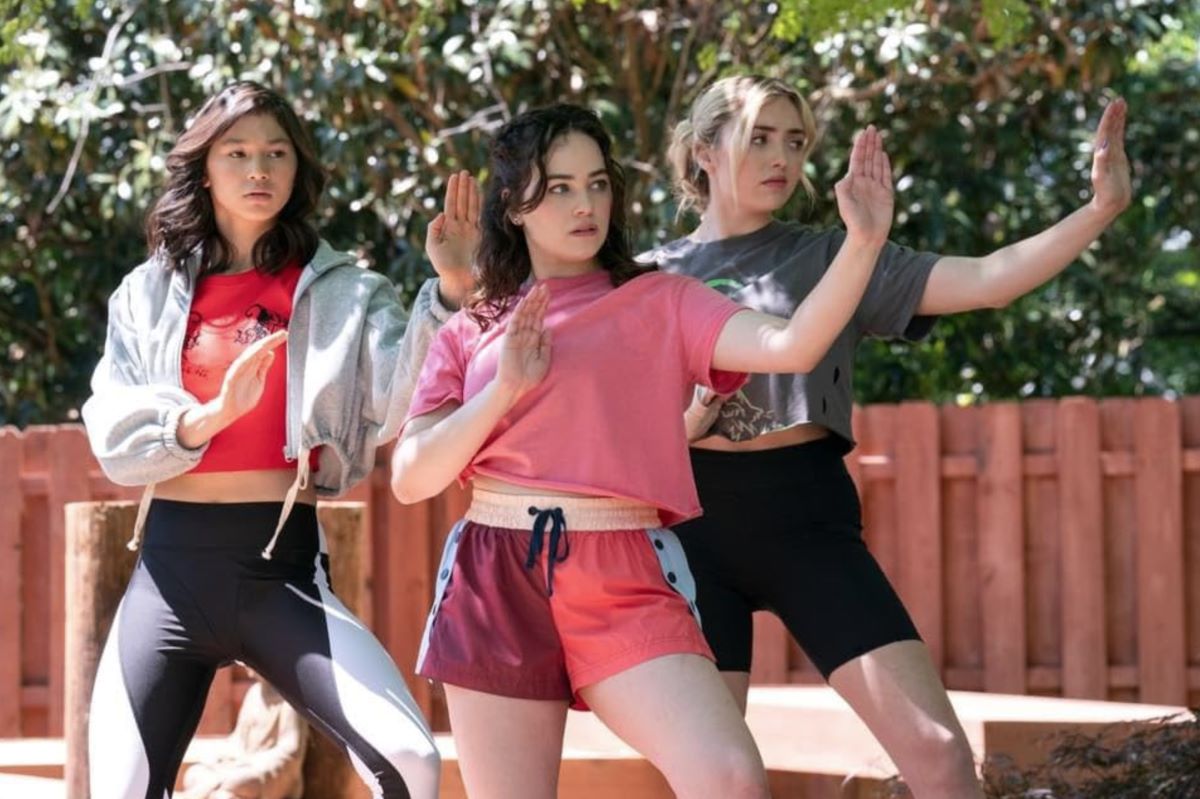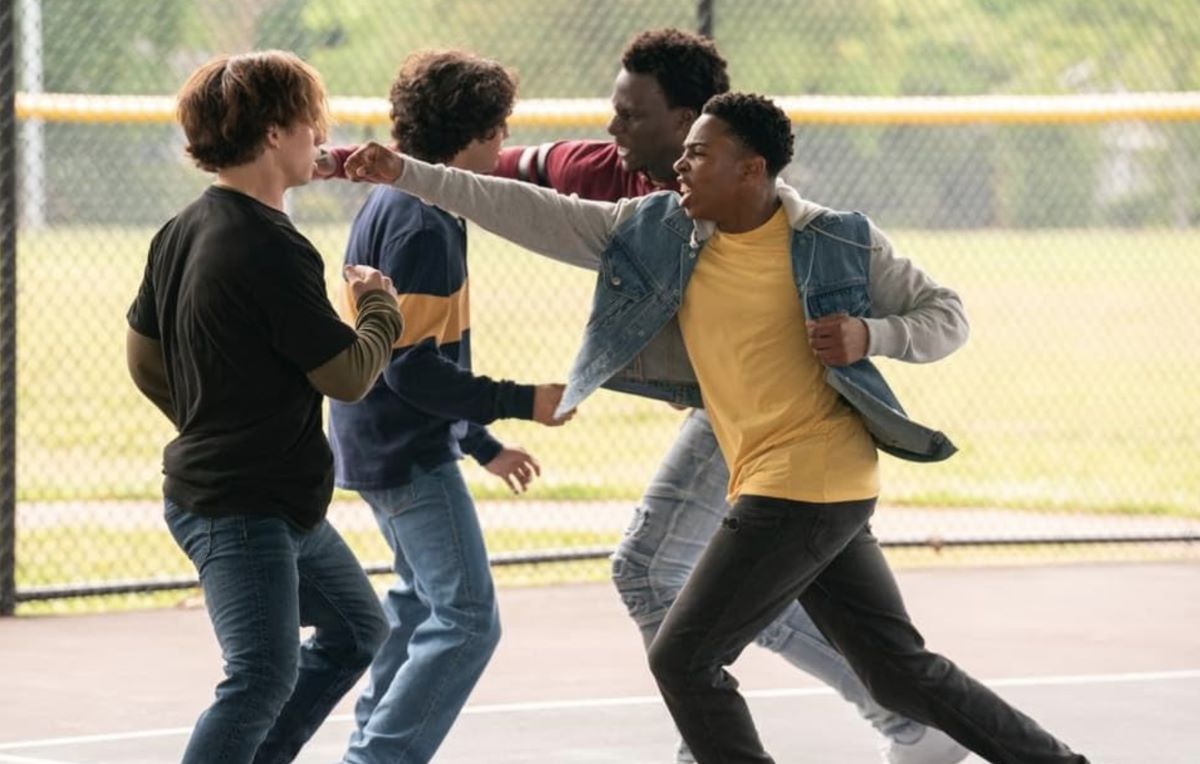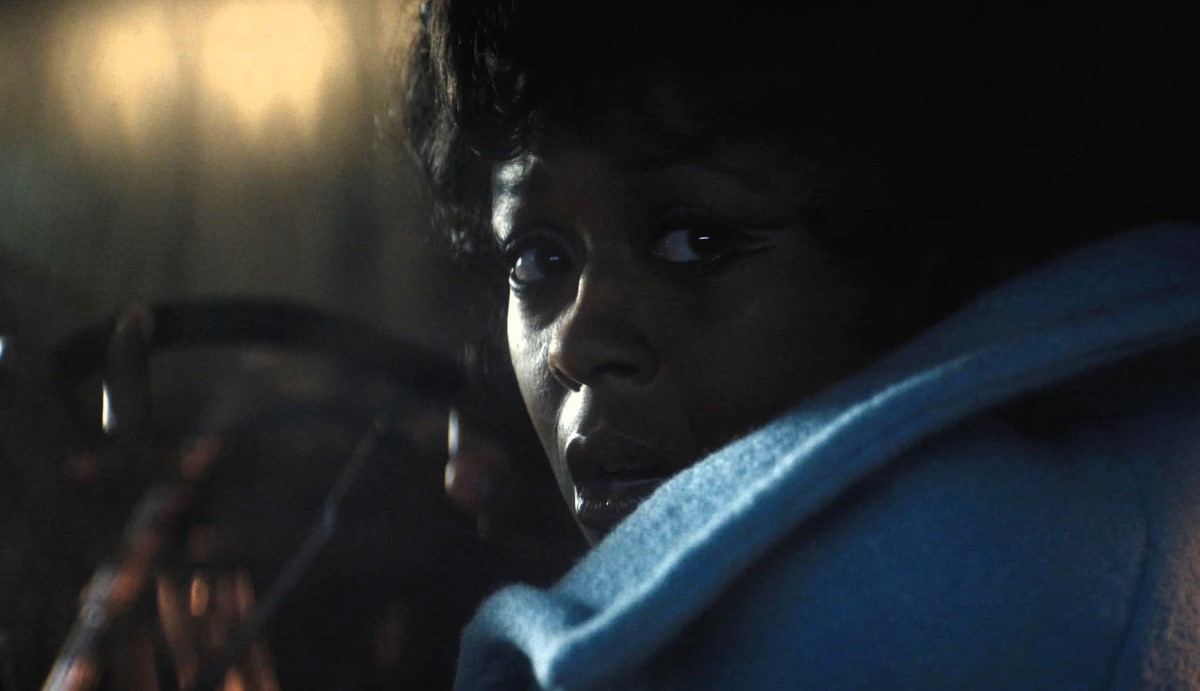Last Week Tonight with John Oliver
Season 9 Episode 12
Aired on May 22, 2022
Main segment: Subway franchise relations
Other segment: 2022 Pennsylvania gubernatorial election
* * *
[Rock music]
♪ ♪ ♪ ♪
[cheers and applause]
John: Welcome, welcome, welcome to “Last Week Tonight!” I’m John Oliver. Thank you so much for joining us. It has been a busy week. Finland and Sweden applied to join NATO, George W. Bush basically admitted to war crimes by accident, and monkeypox cases were reported in multiple countries, to which we all collectively said, “not now!” But we’re going to start with the midterm elections. On Tuesday, all these states [Pennsylvania, North Carolina, Oregon, Idaho, Kentucky] held their primaries, resulting in, among other things, Madison Cawthorn losing his, meaning he’s now officially set a record for shortest term to ever be served by a little bitch. Although perhaps the most consequential news came out of the key swing state of Pennsylvania. Their republican senate race seems headed for a recount after David McCormick and Oprah’s worst giveaway wound up in a near-tie. And their gubernatorial race saw this alarming result.
In the race for Pennsylvania governor, a Trump favorite won the republican nomination. Far right state senator Doug Mastriano enthusiastically promoted the lie that widespread election fraud led to the former president’s 2020 defeat. He also marched on the Capital on January 6th, though Mastriano says he never broke the law.
John: Yeah, he marched on the Capitol on January 6th, something which has become a weird point of pride for republicans. It’s like hearing someone brag that they were on the boat the night Natalie Wood died. I don’t know what’s more troubling — that you think that makes you sound good or that some people might actually agree with you. But Mastriano went beyond marching. As state senator, he held a hearing amplifying Trump’s election conspiracies, featuring special guest Rudy Giuliani. And he’s made it clear that he’s acutely aware of how much power he’d have as governor over the next election.
I could decertify every machine in the state with the stroke of a pen via my secretary of state. I already have the secretary of state picked out. It’s a world-class person that knows voting integrity better than anyone else in the nation, I think, and I already have a team that’s gonna be built around that individual.
John: Wow, that’s ominous. I don’t know who he’s got in mind, but I do know that there’s no way they’re a world-class person. Because, one, anyone Mastriano likes is immediately suspicious, and two, the only truly “world-class” people on the planet are Dolly Parton and… end of list. And even if Mastriano didn’t seem hell-bent on throwing elections to Trump, he would be a nightmare. He’s promised to establish Pennsylvania as a second amendment sanctuary and supports a total ban on abortion with no exceptions for rape, incest, or situations where the mother might die. Which isn’t really a surprise, as he tends to wear his faith on his sleeve, and sometimes even around his neck, with an array of message ties, including this burgundy disaster that says, “gave proof through the night, in God we trust,” which is… Not how that song goes. This chaotic nightmare with words like “praise God” and “praise him” in a design I can only describe as “biblical Xerox mistake.” And this one that says, “with God, all things are possible,” which I’m guessing comes from the JCPenney “youth minister dui hearing” section. And Mastriano has flirted with the extreme fringes of his party. Just recently, he was advertised as a speaker for a conference organized by Francine and Allen Fosdick, self-described prophets who have long promoted QAnon. And while, in the past, his spokesperson has tried to distance him from those people, saying he “strongly condemns the QAnon conspiracy theory,” he not only turned up to the event but was presented onstage with an unusual gift.
We just thank you for being a part of this conference, being a part of all of our lives, and really making a difference and setting a precedent for Pennsylvania, but not only Pennsylvania, for our country. Thank you, both of you, so much. Amen.
Oh, yeah. Where’s Goliath?
John: You know, it’s genuinely hard to pick the wildest part of that — from the plastic eagle that seems to be telepathically screaming “I had nothing to do with this,” to this gentleman’s all-American flag eleganza, to the fact Mastriano was given a full-sized sword as a gift, a token of appreciation that screams “have fun getting this to your car.” Anyway, the fact is, Mastriano is now the republican nominee and will be running this fall against democratic candidate Josh Shapiro, who’s currently the state’s A.G. He actually ran unopposed, so he didn’t have to campaign. But he chose to get involved in the republican race anyway by running ads clearly designed to boost Mastriano among the conservative base.
If Mastriano wins, it’s a win for what Donald Trump stands for.
This statewide ad is paid for by Shapiro for Pennsylvania, gambling that by boosting a more right-wing candidate in a swing state, democrats come out on top this November.
John: Well, that is fucking risky. Because look, I get the tactic behind wanting to choose an opponent that you think you have a better chance of beating. But as has been made painfully clear over the last decade, the most extreme republican isn’t necessarily the least electable. So I really hope democrats know what they’re doing with Mastriano, but they’d be making a huge mistake in underestimating him. Because, if I may quote my own favorite tie, “all things are possible, and most of those possibilities are very bad.” And now this.
* * *
Announcer: — Some things they say in Texas.
There’s a saying in Texas “when you’re bird hunting, shoot at everything, take credit for anything that falls.”
As we say down here in Texas “why using nutcracker if you’ve got access to a sledgehammer.”
We have a say in here, “the only thing you find in Texas in the middle of the road is yellow stripes and dead armadillos.”
WE say in Texas, “for every rat you see, there’s 50 you don’t.”
As we say back in Texas, “don’t be ??? and tell me it’s raining.”
In Texas we have a deal called “don’t let your alligator mouth overload your hummingbird rear end.”
I’m not even sure what that means.
Well, as they say in Texas, “hogs get slaughtered.”
“If he were bacon, he wouldn’t sizzle.”
He looks like a hornswoggle.
Close the barn door before the cow gets out.
As we say in Texas, “that ain’t no polar bear.”
As we look at this in Texas, “all hat, no cattle.”
As they say down in Texas, “all hat, no cattle.
She is all hat, no cattle.
What the Texans call “all cattle, no hat.”
No…
* * *
John: Moving on. Our main story tonight concerns sandwiches. Specifically, Subway sandwiches, dad’s attempt at dinner. It can seem like Subway’s in the news pretty often, and it’s rarely for anything good.
Fast-food chain Subway being sued for fraud accused of selling tuna that isn’t actually tuna.
Ireland’s supreme court says Subway’s bread can’t legally be called bread because it contains too much sugar.
Subway customers are filing lawsuits against the global sandwich chain saying its footlong sandwiches aren’t really a foot long.
These are the shocking pictures that started everything. They were posted on a social media site and one shows a man putting his genitals on what appears to be Subway bread dough with the caption, “I will be your sandwich artist today.”
John: Look, blurred or not, that penis isn’t even the most offensive part of that photo. Look at the bread. It looks like a child’s drawing of Ed Sheeran. And the sad thing is, you know, just by touching the bread with that penis, the penis is ruined forever. He’s got no choice but to just throw it in the trash. But of course, when you hear “P.R. Nightmare for Subway,” your head immediately goes to this man, Jared. He was the face of Subway for 15 years after claiming he lost 200 pounds, thanks in part to eating Subway every day. He even featured in news puff pieces like this, that play a lot differently in hindsight.
Jared takes his pants on the road 200 days a year, speaking to kids about nutrition.
Everybody needs to make sure they make really, really good healthy decisions every day, so they never, ever put themselves in a position to have to wear Jared’s old pair of pants.
John: Yeah, you heard him, kids! Stay out of Jared’s pants. Nothing good happens in there. Subway’s clearly been on the receiving end of a lot of terrible stories, and to deal with each one just quickly: Jared’s a monster and Subway should’ve always been suspicious of a man willing to eat their terrible product every day. Not-quite a footlong? That is a bullshit lawsuit, didn’t go anywhere. Dough-dong? That did happen, and it’s objectively funny. Ireland’s court ruling that Subway’s bread can’t be called bread? The company insists, “Subway’s bread is, of course, bread.” And if you’re curious about the tuna, you can just visit Subwaytunafacts.com, a real website the company felt it had to launch to debunk tuna myths. Although the moment you’ve done that, it does feel like you’re already losing the argument. But even putting all those stories aside, Subway’s still worth looking at tonight for a number of reasons, starting with the fact that it’s a lot bigger than you might think. Subway’s actually the biggest restaurant chain in the U.S. by number of locations, and for awhile, they had the most locations of any restaurant worldwide, beating both Starbucks and McDonald’s. But in recent years, things have taken a turn. Thousands of its restaurants have closed, and some franchisees — the people who own and operate their restaurants — are getting restless. Here in the U.S., 100 of them got together and wrote an open letter last year, stating that “for many of us, this dream has turned into a nightmare.” And overseas, franchisees have given interviews like this.
Are franchisees frightened?
People are terrified. I feel threatened, because I’m scared if they target us.
Franchisees claim many want to get out, but say they can’t because head office won’t approve it unless expensive refurbishments are done.
We want to escape, but they make it impossible for us to sell.
John: Holy shit. You know it’s serious when they use a voice modulator that can only be described as “Autotuned André the Giant.” And remember, this is about a restaurant that sells ham sandwiches. What’s the worst Subway could do to that man? Make him eat one? And if your franchisees are giving interviews like they’re in witness protection and the public is constantly debating if your bread is bread, your tuna is tuna, and whether or not your sandwiches are filled with dicks, something has clearly gone very wrong. So tonight, let’s talk about Subway: where it came from, what its business model is, and why there are so fucking many of them. And let’s start with a little history. Subway was founded as a single sub shop called Pete’s Super Submarines back in 1965 by Fred DeLuca, who ran the company until his death in 2015. And to give you a sense of what kind of manager he was. The company once distributed a literally not safe for work calendar to its employees, featuring photos of shirtless Subway executives, including Fred as Mr. January. And I have a lot to say about this, the least important of which is, why is this guy in a bathroom? The theme is clearly “business but make it nipples” not “Polaroids of uncle Dale before a scrub down.” Anyway, from the very beginning, DeLuca was absolutely obsessed with expansion. Even though the business didn’t make a profit for 15 years, he kept opening Subways anyway, in order to, as he later said, “create the image of success” so it really seems that Subway’s business strategy was basically, “fake it till you make it,” which apparently, our lawyers say I cannot suggest also applies to their tuna, so I won’t. I will not suggest that. The point is, DeLuca had an insatiable desire for growth. Which may be why, in the mid-’70s, Subway moved to the franchise model. The benefit for the company being that they could have more locations that way, and the benefit for franchisees, theoretically, being that they could sell an established product with brand recognition with the promise of being their own boss. And there’s actually one other key draw about Subway specifically, and that is just how simple it is to open one.
Subway’s extreme ubiquity all comes down to their streamlined setup. No deep fryers, no gas grills, so they can build pretty much anywhere. Got a plug? That’s practically all it takes to open a Subway.
John: It’s true. You really don’t need that much to open a Subway, although I’m not sure how reassuring it is that all you need is a plug. After all, it’s a restaurant serving human food, not an air mattress. But Subway’s start-up costs have indeed been significantly lower than many of its competitors. It usually costs between around $200,000 and $500,000 to open a Subway, compared with a McDonald’s, which can cost between 1.3 million and nearly 2.5 million. And that might help explain why Subway owners tend to be individuals and families, many of them immigrants, unlike chains such as McDonald’s, where many restaurants are operated by investment firms. But that low entry fee comes with some significant catches. First: Subways bring in a lot less money than other chains. An average one generates around $400,000 a year compared to the average Jimmy Johns which brings in more than double that or an average McDonald’s, which generates over $3 million. But on top of that, Subway franchisees also have to pay a lot more back to their company. Because while McDonald’s asks its restaurants to pay them eight percent of gross sales, Subway demands 12.5%. Specifically, an 8% royalty fee and another 4.5% that goes toward advertising. Those are some of the highest fees of any chain. Although I will say, Subway puts those ad fees to heavy use. Because they are the reason you can’t turn on your tv without being bombarded by commercials featuring Steph Curry, Tom Brady, and Megan Rapinoe pretending they’re all standing in the same place and willing to put sloppy bread cannons into their god bods. And it’s not just ads. Subway has done a significant amount of product placement in shows and movies like “The Biggest Loser,” “To all the Boys I’ve Loved Before,” and “Chuck.” I was even part of one of them years ago, in an episode of “community,” which I have zero memory of filming. But unlike my forgettable days as a corporate sandwich vessel, some of that placement is pretty hard to miss, like in this incredible scene from “Hawaii 5-0.”
This Subway sandwich, so ono.
Okay, so you’re eating these to lose weight? Is that — is that right?
It worked for Jared, and that boy was large. But the best thing about it, they make it any way you want it. Check this one. Sweet onion chicken teriyaki with jalapeños and banana peppers. Now, you put that with this, turkey BLT, bam! That’s some serious culinary fusion.
John: You know, that scene reminds me of an old Hollywood saying. Every ad exec wants to be a television writer and every television writer is dead inside. But incredibly, even that is subtle next to the product placement Subway engages in overseas. Particularly in Korean dramas, where every plot point seems to occur at a Subway. Here’s two characters having a meeting at one. Here’s a group of men celebrating the fact — real plot point, by the way — their friend just woke up from a coma, and then there’s this scene, which is — I swear I’m not making this up — about a ghost magically eating a Subway sandwich. Subway even released its own mini-drama on YouTube called “Someway,” and I’m going to show you a scene from it now, and I warn you. It is breathtaking.
Han woo-rim!
[Both speaking Korean]
♪ ♪
John: It’s good. I mean it’s really good. And not that you need it, but here’s some context. That character was dating this guy who works at Subway, and every day she ordered the plant-based sandwich because he recommended it to her, until one day, this guy, who — wait for it — also works at Subway, recommended the steak and cheese sandwich for her to mix it up. The sandwiches were a metaphor, you see? Now, she had a decision to make: stay with her usual or go with a new flavor? Which will she choose? Plant or steak? Tried and true or new and exciting? Obviously, she chose the steak, which is why we got that kiss in front of a Subway franchise. It’s art, and it’s cinema, and it’s sandwiches. The point is, Subway advertises a ridiculous amount, and its franchisees benefit from that brand-building. But in return, Subway expects them to work very hard, something made painfully clear in this video created by a regional office, which takes a bit of a turn halfway through.
When you buy a franchise, you enter into a family, the Subway family. We must own what is ours to own. We must lead what is ours to lead. Whether you sell sandwiches, develop stores, or evaluate operations, we must do our part to the best of our ability. Why? Because in this family, people matter, so we don’t let people down by being lazy. We don’t complain about each other’s work. We don’t feel sorry for ourselves, and we certainly don’t give up.
John: Oh, my god. It’s a sandwich cult. And it’s one that should probably think twice about threatening their so-called family members for being lazy when they couldn’t even put in the effort to proof-read their own copy, because this is not how you spell “buy” as in “to buy a franchise,” and they’ve left out the word “to” in this sentence. But to whoever made that video, don’t worry. After all, it’s only two little mistakes. There’s no need to “fell sorry for yourself.” And the thing is, there is only so much a franchise owner can do to increase their earnings, as they’re largely at the mercy of decisions their parent company makes. So if Subway decides to change the menu or redesign the stores, franchisees may be on the hook for those costs. Also, if the company announces a promotion or a discount, stores may have to go along with it, even if it’s a money loser for them. And it gets even worse. Because those already ridiculously tight margins have been exacerbated by Subway’s longtime obsession with expansion. For decades, franchisees have complained about Subway allowing locations to open near each other and cannibalizing their business. In fact, here’s the head of a franchisee association discussing the problem back in the ’90s.
What they tell you when you buy that franchise is, “don’t worry. We wouldn’t put another franchise too close to you. Why would we do that? Why would we want to hurt you like that? You’re one of our partners.” Reality is, they’re going to do whatever they can do that’s not written in black and white, and they do it.
John: Okay, first, that is some dramatic camerawork. But also, power bangs is completely right there. In fact, to this day, Subway franchisees are told that “you will not receive an exclusive territory,” and their contract states, “we and our affiliates have unlimited rights to compete with you.” Meaning a Subway could open right next to yours and cut your sales in half. And none of this really affects Subway corporate. They still get their royalty fees on any sale, plus a $15,000 franchise fee for every new store that’s opened. That is why these stores are fucking everywhere. There are literally ten Subways in a one-mile radius of where I’m sitting right now. You could go to all ten stores, order a footlong at each, and be back here in less than an hour. And the reason I know that is I did that, and frankly, I’m instantly regretting my decision. Because now this entire studio is about to smell like a Subway, which, as we all know is the exact smell of “what if bread could fart?” And all of this was by design. Fred DeLuca even once attempted to convince a journalist that more Subway locations raises everyone’s revenues by referencing a graph his 24-year-old son made, which an economist later reviewed, saying, “in my view, this tells us absolutely nothing. If this is true, then why not have 15 Subways on the same block? Wouldn’t they all be doing splendidly? The answer is obviously not.” And that is a lot of sass coming from an economist. “The answer is obviously not” is much like Subway’s spicy Italian Sub — not actually spicy in the least but, given the source, about as spicy as you’re going to get. And encroaching on their own territory isn’t the only way Subway has angered franchisees. Because their corporate structure has long involved something called Business Development Agents. These are individuals — often franchise owners themselves — who control a certain area and are tasked with finding and approving new people to open stores, getting a cut of royalties for doing that. They’re also in charge of overseeing inspections of stores in their area. And for many years, franchisees have complained about development agents being exceptionally harsh with those inspections, with one saying he was once marked up for slicing his vegetables in a “choppy” manner. Which seems pretty petty. How else would you do it? And there’s an incentive for development agents to be overly harsh, because if a store gets multiple violations, that franchisee’s agreement can be terminated and the store can be re-sold, sometimes to the business development agent themselves at a discounted price. One former inspector even described a development agent telling her the exact store owners that he wanted to fail, adding, “I was kind of his hit man.” You know, normal sandwich stuff. Now, I have to tell you. Subway insists it’s transitioning away from using development agents in the U.S. and from having them be the ones overseeing inspections. But even so, you might well be wondering, given everything you’ve seen so far, “why on earth would anyone want to open a Subway when it has some of the highest royalties, some of the lowest sales, and a new store could conceivably open right next door to you?” Well, crucially, potential owners often don’t fully know what they’re signing up for. Here’s one Subway franchisee inadvertently making this point.
I bought my original store from a guy who was involved with Subway, had been involved for about five years before me. And that store, little did I know, was the lowest volume store in the market. When I went to my first owners meeting, him and his buddy said, “hey, lollipop,” and I said, “why are they calling me lollipop?” And they said, “well, we needed a sucker to buy Columbus,” which was the Subway, right? Out of 91 stores in the market, it was 91st.
John: Yeah, that’s not great. Is it? Ideally you would have that kind of information before you invested. It’s hard to tell how successful a Subway is just from looking at it, especially because from the outside, they all look like “the worst one.” Currently there is no easy way to find out what you might earn before you open a new Subway, for two reasons. First, the company won’t tell you. Generally, when it comes to franchises, the FTC requires that you are provided with what’s called a franchise disclosure document, giving you information before you invest. But it doesn’t require companies to include any details about how stores do financially. Now, some companies do provide this, but it’s voluntary. Firehouse Subs, for instance, has 17 pages dedicated to financial performance, burger king’s includes 11 pages, but Subway has just two paragraphs in which they say, “we do not make any representations about a franchisee’s future financial performance or the past financial performance of franchised outlets.” Instead, Fred DeLuca encouraged potential owners to simply do this.
You know what we really want people to do is go find out from other franchisees rather than relying on what we might tell you. It’s much better experience to talk to 10, 20 franchisees. Some will be doing very well, some won’t do very well, and you can then size up the business.
John: Yeah, or you could just tell them instead of making them go to 20 different Subway stores. I guess, luckily for them, you can find 20 of them on any one block in America. But it’s really the principle of the matter here. But getting accurate info can be very hard to do. For starters, some franchisees may be reluctant to speak because a few years ago Subway added an aggressive non-disparagement clause in their contract. And while it’s true that there’s a carve-out saying you’re not prohibited from sharing information in good faith with any prospective franchisees, as one of them told congress a few years ago, many are reluctant to trust someone calling and asking questions, and for obvious reasons.
So, people always talk about doing due diligence in the industry before they buy a franchise. Well, one of those parts of the due diligence is calling existing owners. Most franchise agreements have that non-disparagement clause in it. I can tell you if I’m in one of my stores and somebody calls me and starts asking questions and let’s say I have a negative experience, am I going to really say so? I don’t know who’s on the other end of the line.
John: Exactly. You have no idea who might be calling. It’s frankly all the more reason why you should just never answer your phone. Calling people is for divorcees and serial killers. I haven’t answered my phone in ten years now. Either text me or forget me. And look, lots of the problems you’ve seen tonight exist in some form with almost all franchises. But Subway in particular seems like the absolute worst. And for years, their store owners have begged them to be less restrictive, with some even releasing that open letter last year, complaining about many of the things that we’ve mentioned tonight and alleging whenever they’ve spoken out about any of these issues to the media, they’ve been silenced by cease and desist letters, biased arbitrations, and forced non-disclosure agreements. But rather than listening to that, Subway’s made things even worse for them. They recently updated their contract for new and renewing franchisees, which, among other things, expands the non-disparagement clause to include subjecting the Subway brand to ridicule, which, come on, Subway. You’re the one who made your new logo two arrows 69-ing each other. The call is coming from inside the house here. It’s frankly no wonder one restaurant industry expert said, “no one in their right mind would sign the new agreement.” So what can we do? Well, I know your instinct might be to now never go to your local Subway. It may have been your instinct before this segment began, and honestly, it remains a good one! But it’s worth remembering, some have spent their life savings on these stores, believing the promise they could be their own boss and are now stuck in a business model that was stacked against them from the start. And to prevent that happening to anyone else, there are things that we should absolutely be doing to better regulate all franchises. The FTC should tighten up their rules on them and make disclosing financial performance mandatory. That would force companies to give a much fuller picture to any potential investors of what they’re getting into. But until that happens or Subway specifically decides to present a more accurate picture of how they operate, maybe we can tell their story for them through their favorite medium. I’m talking, of course, about Korean sandwich dramas. Please take a look.
[Speaking Korean]
♪ ♪
John: That’s our show. Thanks so much for watching. We’re off next week. We’ll be back June 5. Good night.





